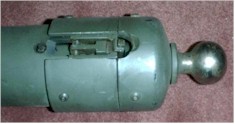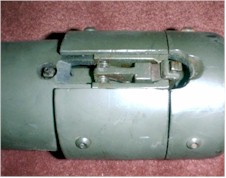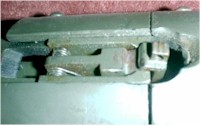
Home
BACKGROUND 
 
 |
Our PVC mortar tube will take the pressure of VERY LIGHT LOADS of black powder with a LOOSE fitting tennis ball. PVC tubes with just wooden end-plugs are used in Fireworks mortars to lift heavier shells but they are buried in sand for safety if one ruptures. I did remote ignition testing and started my loads VERY SMALL and worked them up for maximum range very carefully. PVC was used because it was easy to work with and for the weight reduction over an 81mm steel tube, but there are other units in our group that use metal pipe for their mortar tubes (they don't use bipods). They all use a pre-made charge that they light and drop down the tube then drop a shell made of plastic pipe fittings about 6" long. There is also one that uses empty caulking gun tubes with the tip cut off filled with a little sand and capped with expanding foam, I think these have the lifting charge in them at one end with a fuse. 

 Precussion cap firing mechanism cocked. Our mortar uses loose "F" grain size black powder, the grains are big enough to drop to the bottom of the tube without getting stuck on the side walls. The charges are pre-measured in flip top containers for different ranges. One reason I like to use loose powder is that with the original 81mm bipod you can't dump the tube over to shake out any burning debris that you could get with a separate lifting charge. This is an advantage in that you don't lose your sighting during a quick salvo. The percussion system allows for fast reload time, very similar to the real thing, but has the danger of overheating the plastic tube. There is a metal funnel piece at the bottom of the PVC tube, this was designed to get the powder to drop close to the percussion cap flash hole for positive ignition, and as a way to mount the firing mechanism. It does take the majority of the blast and ignition heat. The funnel end fits in a cone shaped plastic reducing coupling that goes from the 3" PVC tube down to a 2". The funnel was made on the lathe from mild steel, it is threaded to receive the right angle coupler of the nipple flash tube. The flash tube is just a bolt drilled through and tapped for the black powder nipple, and then is threaded and spot welded into the right-angle coupler in the back of the funnel. The firing mechanism body is machined out of aluminum, the hammer,latch and flash tube is steel. The hammer uses an M16 spring, the latch has a coil spring.
Our 81mm Mortar started out with a 2" PVC tube inside the 3" as a bore reducer to fire 1 1/4" white plastic pipe caps with a little fused spotting charge in them. But the 2" PVC was too tight and the plastic "shell" hung up after a few shots, so I changed it to 3" and switched to tennis balls. The NWHA Commonwealth Forces use a 2" steel pipe for a tube with just a steel cap on the end for their Knee Mortar, their shell is also a 1 1/4" white plastic pipe cap but with about 6" of 1 1/4" white plactic pipe glued in it. They use a seperate fused lifting charge. As the I.D. in the 2" steel pipe is slightly larger than 2" PVC their shells don't hang up as the tube gets dirty. This combo would also probably work well for a US 60mm. |